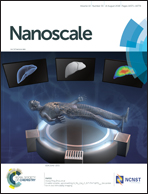Effect of pore density on gas permeation through nanoporous graphene membranes†
Abstract
Pore density is an important factor dictating gas separations through one-atom-thin nanoporous membranes, but how it influences the gas permeation is not fully understood. Here we use molecular dynamics (MD) simulations to investigate gas permeation through nanoporous graphene membranes with the same pore size (3.0 Å × 3.8 Å in dimensions) but varying pore densities (from 0.01 to 1.28 nm−2). We find that higher pore density leads to higher permeation per unit area of membrane for both CO2 and He, but the rate of the increase decreases greatly for CO2 at high pore densities. As a result, the per-pore permeance decreases for CO2 but remains relatively constant for He with the pore density, leading to a dramatic change in CO2/He selectivity. By separating the total flux into direct flux and surface flux, we find that He permeation is dominated by direct flux and hence the per-pore permeation rate is roughly constant with the pore density. In contrast, CO2 permeation is dominated by surface flux and the overall decreasing trend of the per-pore permeation rate of CO2 with the pore density can be explained by the decreasing per-pore coverage of CO2 on the feed side with the pore density. Our work now provides a complete picture of the pore-density dependence of gas permeation through one-atom-thin nanoporous membranes.



 Please wait while we load your content...
Please wait while we load your content...
